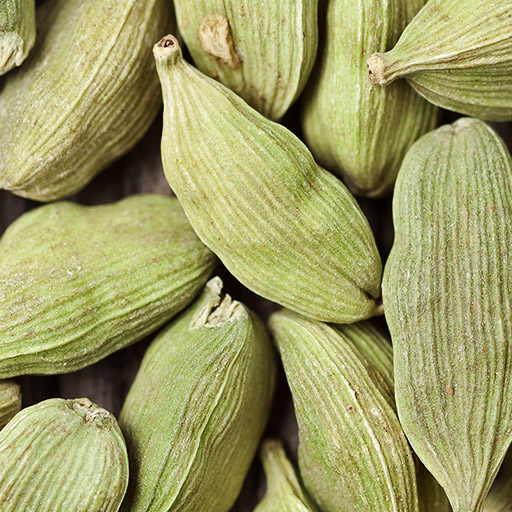Cardamom
All about Cardamom
Elettaria cardamomum

Basic Information
A close relative to Ginger, Cardamom is known as being the most expensive cooking spice and for being beneficial to the digestive system in a variety of ways. Cardamom is commonly used to help reduce indigestion and nausea, and to soothe stomach discomfort and promote digestion. Its distinct scent can lessen motion sickness while promoting a positive mood. Cardamom has profound effects on the respiratory system due to its high 1,8-cineole content, which promotes clear breathing and respiratory health. Native to Southeast Asia, Cardamom is added to traditional Indian sweets and teas for its cool, yet minty aroma and flavor.
Introduction
- Plant Part: Seed
- Extraction Method: Steam distillation
- Aromatic Description: Spicy, fruity, warm, balsamic
- Main Components: Terpinyl acetate, 1,8-cineole, linalool
Usage
- Aromatic: Use three to four drops in the diffuser of your choice.
- Internal: Dilute one drop in 4 fl. oz. of liquid. Or add it in foods or drinks.
- Topical: Apply one to two drops to desired area. Dilute with carrier oil to minimize any skin sensitivity. See additional precautions below.
Main Function
- Eases indigestion and maintains an optimal gastrointestinal balance
- Promotes clear breathing and respiratory health
- Calms stomach upset and uplifts mood
- Flavorful spice for cooking and baking
Application
- Use internally as part of a daily health regimen to support healthy gastrointestinal function.
- Add to bread, smoothies, meats, and salads to enhance food flavor and aid digestion.
- Diffuse or inhale to alleviate feelings of nausea or motion sickness.
- Diffuse or apply topically to promote clear breathing.
Cautions
If you are pregnant, consult your physician before using essential oils topically or aromatically.
Plant Science
Asthma
Human clinical research (n=32) suggests that 200mg of cineole, a constituent of cardamom oil, taken orally three times a day for twelve weeks may supplement treatments of steroids for asthma. The treatment reduced steroid dosage by as much as 36%.(1)
Anti-Inflammatory
In vitro research suggests that cardamom essential oil may inhibit protein expression in skin cells that regulate the inflammation process such as VCAM-1 and M-CSF.(2)
Anti-Microbial
In vitro research suggests that cardamom oil may be effective against various pathogenic microorganisms including Bacillus pumilus, Staphylococcus aureus, Staphylococcus epidermidis, Pseudomonas aeruginosa, Saccharomyces cerevisiae.(3)
Anti-Nausea
Human clinical research (n=303) suggests that a diffused blend ginger, spearmint, peppermint, and cardamom oil (1:1:1:1) may be effective at attenuating nausea.(4)
Bronchitis
Human clinical research (n=640) suggests that myrtol, which contains cineole, a major constituent of cardamom oil, along with alpha-pinene and limonene, was an effective and safe treatment of acute bronchitis when taken orally. The study suggests that myrtol (4 x 300mg, orally, for 14 days) may outperform common active treatments.(5)
Digestive Health
Animal research suggests that 50mg/kg of cardamom oil, administered orally, protected rats from chemically-induced stomach ulcers. The same property could potentially be protective to humans.(6)
Sinusitis
Human clinical research (n=152) suggests that 100mg of cineole, a constituent of cardamom oil, taken orally three times a day for seven days may reduce symptoms of sinusitis before antibiotics are needed.(7)
